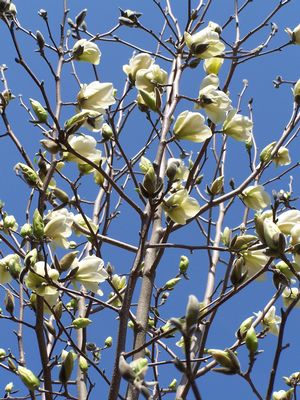View All Plants :: View All TREES
Magnolia x 'Ivory Chalice'
Magnolia
Plant Type:
TREESMagnolia x ‘Ivory Chalice’ – This is one of the less commonly available hybrids from the cross of M. acuminata with M. denudata. It is a vibrant grower with gorgeous creamy yellow fragrant 6” wide chalices in May occurring in such numbers that it is like a mind-blowing detail of the Milky Way. The heavy-textured waxy blooms fade to ivory. Large paddle-shaped leaves often turn golden brown in autumn. The bark is smooth and light silvery brown, attractive in the winter landscape. Site it in moist, fertile soil in part to full sun. This is another magnolia that we have some difficult rooting; therefore, we may be lucky enough to successfully root but a few and perhaps not every year. Northern gardeners: spring planting is strongly advised.
Characteristics and Attributes for Magnolia x 'Ivory Chalice'
Season of Interest (Flowering)
- Spring
Season of Interest (Foliage)
- Spring / Summer / Autumn
Interesting Bark
- Smooth
Autumn Interest
- Autumn Leaf Color
- Showy Buds
Nature Attraction
- Deer Resistant
Light
- Mostly Sunny
- Full Sun
Attributes
- Fragrant
- Specimen
- Alee
Growth Rate in the Garden
- Rapid
Soil
- Fertile
- Organic
- Moist
Origins
- Garden Origin
Propagated By
- Cutting Grown
Genus Overview: Magnolia
Common Name: Magnolia
The Magnolias are one of the earliest known flowering plants to establish themselves on our beautiful planet. Much breeding continues and the cultivar list is expanding with some smaller sizes and new flower colors. Many are typical tree forms while some tend to be multi-stemmed – more like huge shrubs than single-stemmed trees. Most are spring blooming – some early, others later after danger of frost has passed in the north. A few of these will provide some recurrence of bloom during the summer. A handful bloom in summer. Many emit wonderful fragrance. The foliage is often large, bold and paddle-shaped, looking attractive in summer; a handful of species’ leaves are so large that they are reminiscent of banana foliage. Some seasons they develop gold to golden brown autumn color before the leaves drop. It’s hard for me to think of a landscape without one or more included in the mix. All prefer fertile deep loam with plenty of organic matter and moist soils – some are even content in relatively wet conditions. Magnolias should be sited in full to half sun exposures. All our selections are cutting grown, on their own wood – they are not grafted. Some are much easier to produce on their own wood than others; some are quite recalcitrant. In that, we may not always have certain plants available or available in great numbers. Spring planting is recommended for magnolias especially up north. Cutting grown.


